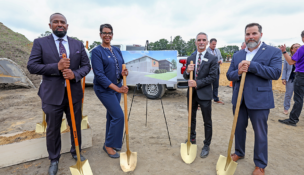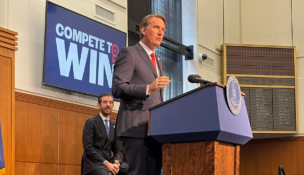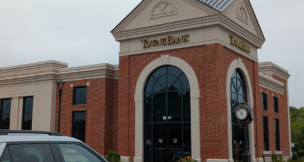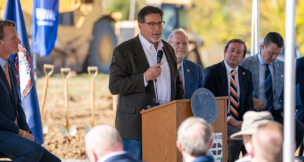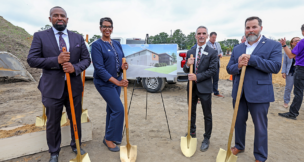Growth in the valley
Shenandoah attracts businesses from Northrop Grumman to Buc-ee’s

A February groundbreaking ceremony for Northrop Grumman’s Waynesboro manufacturing facility was attended by Gov. Glenn Youngkin and the Fortune Global 500 government contractor’s chair, CEO and president, Kathy Warden. Photo courtesy Office of Governor Glenn Youngkin

A February groundbreaking ceremony for Northrop Grumman’s Waynesboro manufacturing facility was attended by Gov. Glenn Youngkin and the Fortune Global 500 government contractor’s chair, CEO and president, Kathy Warden. Photo courtesy Office of Governor Glenn Youngkin
Growth in the valley
Shenandoah attracts businesses from Northrop Grumman to Buc-ee’s
It can take a village — or a valley — to attract a multinational corporation.
Shenandoah Valley economic and workforce development officials combined forces to entice Northrop Grumman to locate a 315,000-square-foot advanced electronics manufacturing and testing facility on a 63-acre site in Waynesboro, a project announced in November 2023.
Construction of the $200 million-plus project is well underway, according to Jay Langston, executive director of the Shenandoah Valley Partnership in Harrisonburg. A groundbreaking ceremony attended by Virginia Gov. Glenn Youngkin and Northrop Grumman Chair, CEO and President Kathy Warden was held in February for the facility, which is expected to be operational by 2026.
The Falls Church-based aerospace and defense giant anticipates creating an estimated 300 jobs — mostly a variety of engineering and manufacturing positions — over the next five years.
“The Northrop Grumman model opens up a new sector in manufacturing electronic components unlike anything we’ve had,” Langston says.
Northrop Grumman employs about 95,000 employees — 6,800 in Virginia —
and reported $39.29 billion in 2023 revenue. This year, the company ranked No. 109 on Fortune magazine’s annual Fortune 500 list and No. 382 on its Global 500 list.
“Northrop Grumman has put its faith in us. It’s a big name. It’s a statement for us,” says Langston, adding that regional economic development officials plan to promote the Waynesboro facility as an example for attracting other advanced manufacturing companies to the region.
Manufacturing overall is big business in the Shenandoah Valley, employing more people than any other private sector industry, according to a December 2020 SmartAsset report.
Greg Hitchin, Waynesboro’s economic development director, appreciates the importance of Northrop Grumman’s decision to make such a big investment in the valley. “It’s a tremendous opportunity” for the city to attract “new manufacturing of this caliber,” he says.
Hitchin led a team to “work through all factors we needed to get this here. … We got a GO Virginia grant to do our due diligence work ahead of time.” That $821,000 grant, awarded in July 2021, allowed the city to perform due diligence on nine sites, totaling 1,182 acres.
In November 2023, Gov. Glenn Youngkin said he had approved an $8.5 million grant from the Commonwealth’s Opportunity Fund to assist the city in securing the NG project, and the Virginia Economic Development Partnership’s Virginia Talent Accelerator Program is providing Northrop Grumman with employee training and recruitment services at no charge.
Hitchin believes one of the key reasons Northrop Grumman chose Waynesboro was the fact that the location had been upgraded to a Tier 4 site, a state site-readiness designation meaning that all infrastructure permit issues have been identified and quantified, and that plans for necessary infrastructure improvements have been completed and approved. Tier 5, the highest designation, is for shovel-ready sites, and “zero is a cornfield,” Hitchin says.
A new access road to the Northrop Grumman Waynesboro site is being funded by a Virginia Department of Transportation grant.
Now, he says, “the building is going up. The concrete walls are up. It changes every day. It’s well on the way to meeting its schedule.”

Timely training
Another factor that may have helped draw Northrop Grumman to Waynesboro is access to the valley’s strong workforce development programs.
“Our mechatronics program is something that is going to be very valuable” to Northrop Grumman, as well as to other advanced manufacturing companies, says John Downey, president of Blue Ridge Community College in Weyers Cave.
Mechatronics, he explains, is the integration of mechanical systems with electronics and software. “We teach the basics. They train on the more specific,” Downey says.
BRCC is working with Piedmont Virginia Community College in Charlottesville, near Northrop Grumman’s Albemarle County plant, which produces maritime systems and equipment. BRCC also is working with James Madison University, regional technical schools and even high schools on associated workforce development efforts.
That’s because Northrop Grumman and other high-tech companies don’t just need high-tech training; they also need workers trained in accounting, human resources and other professions.
“The education system in the valley provides the gamut,” Downey says. “We even train and test CDL drivers. It saves [companies] time. They can get people on the road a lot sooner.”
Key workforce development issues on the horizon are artificial intelligence and cybersecurity, Downey adds. “That’s a huge growth area for community colleges. We need to be in the forefront, helping not only big manufacturing companies but also smaller businesses in the community.”
The Shenandoah Valley is home to various kinds of manufacturing — such as food, medical and pharmaceuticals — that help keep the region recession-resistant, Downey says.
The food and beverage industry — from growing and processing to packaging and transporting — remains “by far our dominant sector” in the valley, according to Langston.
“Agriculture is so important to us, but we take it for granted in general. We want to better celebrate it,” he adds. The Shenandoah Valley is home to four of Virginia’s top five agricultural counties — Rockingham, Augusta, Page and Shenandoah — producing more than $1.3 billion annually in commodities sold, according to the 2022 U.S. Department of Agriculture Census.
Agricultural production is a huge investment and a great engine for jobs, according to Langston. “People don’t think about who is doing the construction, putting up the silos, providing the equipment. There are people who specialize in all kinds of things that are necessary to make it all work — fuel, equipment dealers, delivery truck, fertilizer, storage.”
Neil A. Houff, president of Weyers Cave-based Houff Corp. and a Virginia Crop Production Association board member, observes that farms in the Shenandoah Valley “are getting bigger and getting smaller.”
Growth is “going in both directions — large and niche. Some midsize farms are consolidating, while some are breaking into niche markets,” Houff says.
What is driving that divide, he notes, is the valley’s proximity to large populations of people of different income levels. “That makes us attractive to traditional food production and traditional farming,” while making room for niche markets such as organic farms and small vineyards.
Sustainability and humane treatment of livestock have become bigger issues in recent years, Houff adds.
Farmer Focus, a partner-owned collective of nearly 100 family farms raising humanely treated poultry, celebrated its 10th anniversary this year. The Harrisonburg-based company plans to add 300 jobs by 2025.
Overall, the poultry industry in the valley has been “pretty steady,” Houff says. The area also is a big beef production area, he says, but most of the beef grown is shipped west for processing because facilities in Virginia facilities are on the smaller side.
What’s more, many existing businesses seem to be in growth mode, Houff adds.
Dairy processing operator HP Hood announced plans this spring to invest more than $83.5 million to expand its Winchester-area facility. The project includes upgrades to production and packaging equipment, as well as construction of additional warehouse and cooler space.
In May, fast-casual Mediterranean restaurant chain Cava opened a 55,000-square-foot production and packaging facility in Augusta County. The company made an initial investment of approximately $35 million in the Verona facility, which manufactures dips and spreads.
Leiber, a German-based manufacturer, is set to invest up to $20 million to establish its first U.S. operation in Innovation Village in Rockingham County, it announced in September 2023.
The new facility, which will extract brewer’s yeast from the byproducts of beer making and process it into animal food, will reflect two aspects of the region’s agribusiness, says Joshua Gooden, deputy director of economic development and tourism for Rockingham County.
Rockingham received a $4.5 million grant from the Virginia Business Ready Sites Program in August for site development at Innovation Village. Gooden says the county plans to build a 20-acre pad site on a 165-acre property in hopes of attracting another large industrial facility.
In addition to its manufacturing draw, the Shenandoah Valley is rich in natural, historic and cultural attractions that power a thriving tourism industry, with lots of state parks, campgrounds, wineries and breweries. Langston says that the region’s abundance of open spaces was a boon to area businesses during the pandemic.
The Virginia Metalcrafters Marketplace, with roots tracing back to the late 19th century, has become an attraction on the edge of Waynesboro for visitors who want to drink and dine. What was once the Waynesboro Stove Co. became Virginia Metalcrafters, a company known for its decorative hardware, fireplace accessories, trivets and other decorative items, although that company closed in 2006.
In 2016, Basic City Beer turned the site into a tourism attraction, opening as the first occupant of what is known today as Virginia Metalcrafters Marketplace.
The self-described “microcosmic brewery” was joined by Common Wealth Crush, an urban winery. Happ Coffee relocated to the market from downtown Waynesboro, and Basic City has expanded since its opening, adding an arcade in its tap room, a speakeasy-style bar and an 800-capacity music venue. Hitchin says a coworking space will be added to the mix soon.
And let us not forget Buc-ee’s, a Texas-based chain of mega-sized convenience stores, which is building a location on Interstate 81 in Rockingham. Owned by Arch “Beaver” Aplin III, Buc-ee’s is known for its huge size and its mascot — a toothy, ballcap-wearing cartoon beaver.
The chain purchased 21.3 acres for the center for $6.6 million in September 2023. Gooden says it’s expected to open in spring 2025. The Buc-ee’s center in Rockingham will be 74,000 square feet and have 120 fueling positions.
Rails and roads
Business success in the Shenandoah Valley depends greatly on its extensive logistics and transportation network, Houff and Langston agree.
Led by the Port of Virginia’s Inland Port in Front Royal, the region’s logistics industry “is essential for us — for manufacturing, agriculture [and] the food and beverage industry,” Langston says.
But since the pandemic, he has seen a slowdown in the desire to build new logistics facilities. “If it’s not overbuilt, it’s very close. Speculative logistics is no longer out there. I’ve heard that this is a countrywide phenomenon.”
Transportation, too, is critical in the valley, which has Interstates 81 and 64 and two major rail lines — CSX and Norfolk Southern — running through it.
“The poultry industry would not exist without rail. Virginia could not support it,” Langston says. “We need corn and soybean meal from the west to feed our animals and our birds.”
Given its importance, Houff is pleased to see plans to improve rail infrastructure in the region.
The Virginia Inland Port has finished $15 million in structural improvements, including three new rail sidings, and it can handle more freight from the Port of Virginia’s ocean terminals, which are set to be the widest and deepest channels on the East Coast. What’s more, the Virginia Department of Transportation’s $3.1 billion Interstate 81 Corridor Improvement Program lists 64 planned upgrades along the 325-mile corridor from Winchester to Bristol.
“The I-81 improvements are going to be a huge plus,” Langston says. “They’ve been needed for years.”

Shenandoah Valley at a glance
The Shenandoah Valley lies between the Blue Ridge and Allegheny mountains, bisected by Interstate 81. The region includes Augusta, Bath, Highland, Rockbridge, Rockingham, Shenandoah, Page and Frederick counties, as well as the cities of Harrisonburg, Staunton,
Lexington, Waynesboro and Winchester. Agriculture remains a key industry for the region, once known as the breadbasket of the South. Advanced manufacturing is growing, and the valley has numerous logistics and food and beverage industries. It’s also a hub for higher education, including James Madison University, Mary Baldwin University, Shenandoah University, Virginia Military Institute and Washington and Lee University.
Population
373,472 (2021)
Top employers
• Amazon.com • Booz Allen Hamilton
• Capital One Financial • Freddie Mac
• General Dynamics • Inova Health System
• Northrop Grumman • RTX
Major attractions
The Shenandoah Valley, which was settled in the 1700s, is known for its historical and cultural attractions, including the Virginia Museum of the Civil War, the Museum of the Shenandoah Valley and the American Shakespeare Center’s Blackfriars Playhouse. The region also is home to such natural attractions as Shenandoah National Park, the George Washington and Jefferson national forests, Natural Bridge and Luray Caverns.
Boutique/luxury hotels
The Blackburn Inn and Conference
Center (Staunton)
8,400 square feet of event space, 49 rooms
The Mimslyn Inn (Luray)
Nearly 5,000 square feet of event space,
45 rooms
The Georges (Lexington)
1,700 square feet of event space,
33 guest rooms
Top convention hotels
The Omni Homestead Resort (Hot Springs)
72,000 square feet of event space,
483 rooms
Hotel Madison (Harrisonburg)
21,000 square feet of event space,
230 rooms
Hotel 24 South (Staunton)
8,500 square feet of event space,
124 rooms
Best Western Plus Waynesboro Inn & Suites Conference Center
5,500 square feet of event space,
75 rooms
Notable restaurants
Local Chop & Grill House (Harrisonburg)
American, localchops.com
The Catamount Lounge (Front Royal)
Cocktails, thecatamountlounge.com
The Shack (Staunton)
New American, theshackva.com
The Joshua Wilton House (Harrisonburg)
American, joshuawilton.com
Zynodoa (Staunton)
Southern, zynodoa.com





